The producers of Jem and the Holograms have said that fans would be happier if we lowered our expectations about the movie. That’s like a fancy restaurant serving us a plate of frozen chicken fingers and telling us we have to like it because expecting a fine dining experience is too needy and emotional. As I said in my previous piece about the Jem adaptation, I get that it’s hard to adapt something people love, but also forgive me if I’m not sad that internet hype cycles and instant criticism are making life hard for the creators of a cheap adaptation that was probably focus-grouped to hell. Eye-rolling pleas for the fans to simmer down doesn’t elide the fact that most of the responses to the trailer have been cogent and thoughtful explorations of the progressive meanings of the cartoon that influenced people when they were children, and not simply exasperated, knee jerk reactions.
But still, we’re here to help, Universal Studios Movie Executives. We’ve compiled a list of elements from the television show that should and should not be inspirations for your adaptation, whether or not they’re actually a part of this adaptation. We understand it’s probably too late, but October is still a long ways away, so there’s always time to get this right.
1. Probably Shouldn’t: Reading and Other Things are Good
Jem often repeats storylines. The most amusing retreads are the several-per-season PSAs that attempted to educate children about the value education and the culture of earlier generations. Such episodes are doubly hilarious because they typically involve the Starlight House girls, Jerrica’s coterie of foster children who were ready and willing to get excited about opera, broadway, magic, the Renaissance and theater.
The best of these episodes, however, are simply about reading. For example, in season two’s “The Treasure Hunt,” Jerrica takes Ashley, Ba Nee and Krissie on a literature-themed scavenger hunt held by some weird rich dude who apparently really cares about kids reading. They are, naturally, forced to compete against Jerrica’s nemesis and leader of the Misfits, Pizzazz, as well as some girls Pizzazz found on the street. Jerrica and the Starlight girls win, and the Holograms sing a song about books, as you do. Even better, a few episodes later, in “Roxy Rumbles,” Roxy, a member of the Misfits, reveals that she’s illeterate when she tries to strike out on a solo career from the Misfits and signs a bad contract. Ba Nee, flush from her victory in “The Treasure Hunt,” gives Roxy a textbook to help her out. Sweet, huh? That Ba Nee. Always around to help you learn to read, at least when she’s not running away or screaming about her long lost dad.
2. Probably Should: Kimber Hates Music Made Before She Was Born
Of course, there are exceptions to every rule. The one version of the PSA storyline that should be referenced, even if only in passing, is Kimber’s utter disdain for music made before she was born.
The two most memorable episodes that deal with this, season one’s “Old Meets New” and season two’s “The Jazz Player,” follow the exact same template: a once-famous musician is down on his luck and the Holograms decide to help him out. Kimber—the primary songwriter of the most famous band in the show’s universe, mind—thinks this is stupid, because who cares about music she didn’t write? Fortunately, she learns a valuable lesson at the end of each episode about how rock ‘n’ roll and jazz are actually great. Which is why it’s awesome in “The Jazz Player” when Kimber asks, “Who cares about a jazz band from the ’40s?”, like she hadn’t already learned this exact lesson about 1950s rock ‘n’ roll in “Old Meets New.” But that’s the best thing about Kimber’s character, of course: she just keeps learning the same lessons over and over, and then immediately getting amnesia when it suits the rehashed plot.
3. Probably Shouldn’t: Aja Has No Actual Personality
Speaking of “The Jazz Singer,” Aja gets a genuinely funny line when she cracks, “You know Kimber: If it didn’t happen last week she’s not interested.” It’s particularly remarkable because of all the main characters, Aja has the least developed personality. I mean, she does have one, but it’s mostly one we’re told about, rather than a personality we see. We’re told she’s a tomboy, but apparently tomboy outfits are less marketable than more traditionally feminine outfits, because she doesn’t dress particularly tomboyishly. She does always drive the Rockin’ Roadster, but we’re never treated to a separate story about her love of cars, and I’m not sure if that’s supposed to be “evidence” of her tomboyism or what. We’re also told Aja is good with electronic equipment, but unlike Shana’s fashion and Kimber’s songwriting, that’s a talent that never manifests in the band’s creative process. It’s Jerrica’s boyfriend Rio who acts as the band’s manager and engineer. In other words, Aja’s a tomboy because she has a vague interest in electronics and cars, but she’s not a master of those things like her sisters are in their arenas of creative expression.
Aja’s main plot line outside of being a Hologram is her relationship with Craig Philips, a drummer who turns out to be the brother of one of the Misfits, Stormer. It’s a cute plot, but otherwise the character of Aja is a great opportunity to expand on one aspect of the cartoon that was undercooked. Make Aja’s role as the gear head more obvious—even better, just make her the band’s producer. If you want her to be a tomboy, make her gender expression less normative. Why not? Expand the range of beauty this franchise celebrates; the cartoon included race in its diversity, but not much else, even among the Starlight kids.
4. Probably Should: Jerrica and Jem Date the Same Rio
One of the greatest pleasures of the cartoon is the utter absurdity of the fact that Rio never figures out that Jerrica and Jem, the two loves of his life, are the same person. Even better: Jerrica spends most of the series jealous of the fact that Rio is in love with both of them, because she’s afraid he finds Jem (i.e., herself) more exciting than Jerrica (i.e., herself).
Why doesn’t she just tell him the truth? The stated reason for Jerrica’s secret identity as Jem, at least in the pilot, is a means to keep Synergy, the futuristic holograph-generating computer, a secret, especially since at that point evil Eric Raymond is still part-owner of Starlight Records. It’s an explanation that would probably make more sense if Kimber, Aja and Shana also had secret rock star identities, but…they don’t, so it’s not like Jerrica’s secret is protecting the location of Synergy if somebody wanted to explore the place where Jem is most likely to be.
After Jerrica fires Eric Raymond from the company (six episodes in), the need for subterfuge makes less sense, especially with Rio, except in a “no evil person should get their hands on this advanced technology” kind of way. The only person who finds out is the president—in “The Presidential Dilemma,” where the Pentagon tries to steal Synergy—and he’s just like, “Cool. I’m not even going to ask why this is an important secret. Or point out that you could publicly be Jem without anybody assuming that it’s a hologram and not just a wig. Or that I could make an executive order that U.S. Intelligence leave Synergy alone. Or whatever.” So Jerrica’s secret remains intact, which often leads to scenes like this:
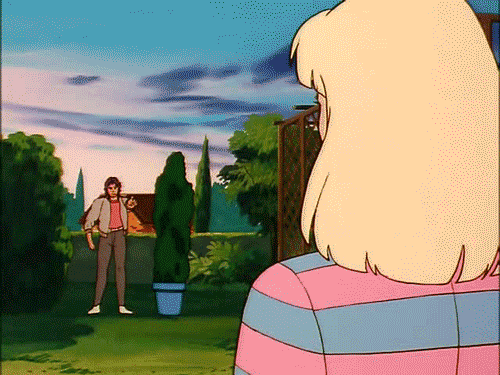
It’s stupid, is the point, but it’s also awesome, because here’s a kid’s show that featured a primary love interest cheating on the main character with the main character’s alter ego, and the main character felt guilty and angry about that. There are a couple of ways to read it: as a parable of the fear many women have that they can’t have it all; or as evidence that Jerrica doesn’t trust Rio because she doesn’t trust men, especially since the only other meaningful men in her life are murderous Eric Raymond and his equally murderous henchmen Zipper and Techrat.
It doesn’t look like this plot is in the movie, because it looks like Ryan Guzman’s Rio is aware of Jem’s identity, but I still wish it was. Like Vince Vaughn says in that True Detective trailer: Sad Rio—especially sad Rio in a neon sports coat—is the best Rio.
5. Probably Shouldn’t: Foreign Excursions
Putting the characters in exotic locales was often just an excuse to put them in new outfits, but various episodes that put the Holograms into a position to interact with people of color are often…racist? It’s well-meaning racism—the message is always that unfamiliar cultures should be valued—but it’s still frequently tin-eared. In most examples, the episodes simply place too much emphasis on the exotic, which means the myths and mysticism of foreign cultures are given precedence over the real lives of people. In others, the philanthropy of Jem and the Holograms is emphasized, and while I’m sure the intended idea is that helping others is good, the image of Jem singing about changing the world while offering food to children in Africa seems pretty antiquated, as does the idea that a white woman can unite the world peacefully through music, and that united world looks like the cover of a Beatles album:
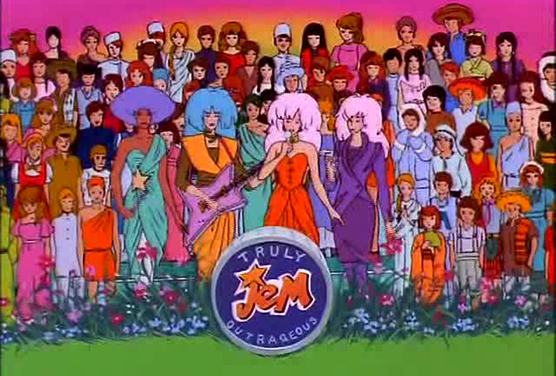
6. Probably Should: Synergy
It’s a super computer that generates holograms that are as useful in music video fashion shows as they are in scaring off various criminals or helping to rebuild Indy 500 cars:

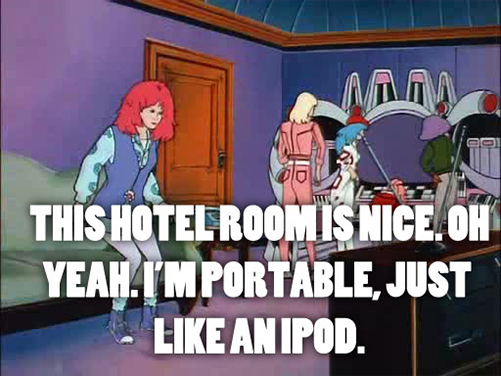
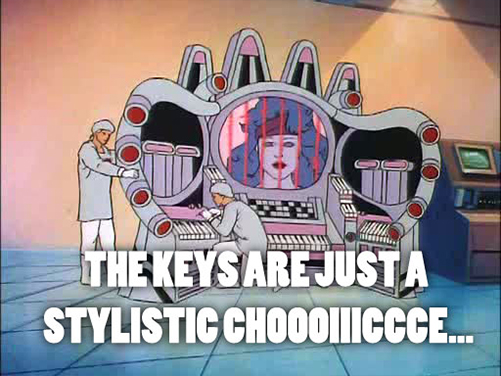
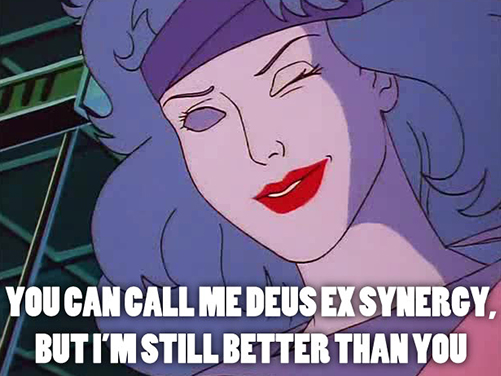
Obviously!
7. Probably Shouldn’t: Kimber’s Boyfriends
Kimber’s boy problems are stupid. Unless you count Rio, all of the other Holograms (minus Raya) had steady beaus throughout the run of the show. Kimber had so many boyfriends that her wedding was interrupted by a proposal from another boyfriend!
To be fair, the show used the boys as a parable for Kimber’s indecisiveness: The boys weren’t ever much more than different aspirational paths Kimber might take. But that also meant they were boring, and since the idea of Kimber being confused about aspirational paths when she was a member of and primary songwriter for the most famous band in the world, these stories never really landed. None of which matters anyway, because…
8. Definitely Should: Stormber
For those not familiar, the idea that Kimber and Stormer are in love stems from a single episode of the show, “The Bands Break Up.” It’s especially amazing that this ‘ship has evolved with such tenacity—the creative team behind the new IDW Jem and the Holograms comic have clearly and directly noted that Kimber and Stormer are canonically queer, which is wonderful—given that this is the only episode of the show to indicate the possibility. In fact, it’s essentially the only episode of the show where Kimber and Stormer meaningfully interact. Seriously. I might have missed a couple of spots, but in my rewatch I noted Kimber and Stormer speaking in only two other episodes. The first is “Journey to Shrangri-La,” where Kimber is trying to save Stormer from a cliff climbing accident and scowls that Stormer needs to “go on a diet” as she struggles to help her up. The second is “Britrock,” where Aja finally discovers that Craig is Stormer’s sister. Kimber does coyly tell Stormer that the Holograms are “not going to bite you” when Stormer tries to walk away, but immediately turns on her when Aja mistakes Craig’s revelation for one of infidelity—that “Mary Philips” is his wife. Stormber ‘shippers can take Kimber’s sharp response for jealousy, but…they never, ever talk again. None of which is to suggest that I don’t totally agree with the theory. Have you seen “The Bands Break Up”?
It starts with Kimber storming out of a band practice because (for the umpteenth time) she feels disrespected because her older sisters won’t take her seriously:
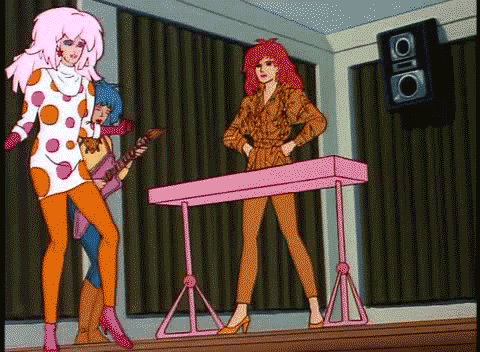
It’s not just that Kimber and Stormer sing to one another while staring into each other’s eyes. It’s not just that the Teen Scene, the bar where Kimber and Stormer have their big break, is filled exclusively with women, and features an all-girl band called—seriously—the Limp Lizards. It is that both Kimber and Stormer leave their respective bands because they feel misunderstood, and both bands act like the two women are going to be bad influences on each other. Kimber starts wearing Misfits-style mascara! Stormer starts standing up for herself! And then they make a “music video”:

Intentionally or not—and what little commentary from the creative team there is seems to suggest “not,” which is somewhat surprising given the specificity of things like “Limp Lizards”—it’s obvious why this story captured the hearts and minds of so many lesbian and bisexual women in 1987, even though it’s 17 episodes later when Kimber and Stormer finally speak again and Kimber is body-shaming Stormer for her weight.
It would be a nice nod to the show’s sizeable LGBT audience to make one of the main characters queer, and Kimber seems the most likely suspect.
9. Definitely Should: The Misfits
In my first piece about the Jem and the Holograms trailer, I noted that not having the Misfits in the movie was like not having the Decepticons in a Transformers movie. But it’s not just that. It also removes the camp from the property. There’s a scene in “Roxy Rumbles” where Eric docks Pizzazz’s paycheck for the 3,422 sequins she used in her last outfit. This is right after Pizzazz has joked that the Holograms are trash, and right before Pizzazz corrects Eric that she only used 2,000 sequins. Phyllis Gabor just does not give a fuck, and despite her murderous ways is a huge part of the cartoon’s charm. Jerrica would try again and again to win the heart of a woman who fundamentally did not believe that Jerrica/Jem was on her level. Roxy and second-season addition Jetta largely supported Pizzazz in her schemes; Stormer was more conflicted, and especially in the first season often clandestinely aided the Holograms.
In other words, the Misfits aren’t simply a plot mechanic that you can excise from the show for efficiency’s sake. I would argue that the Misfits were actually the better band—though that’s my fondness for punk, no wave and new wave directing that argument—but that one implicit message of the show was that if you were disrespectful to others you would not receive respect in return, which is why the Holograms always won. And while I realized there’s a dangerously thin line between a story about respect and a more problematic story about women who are nice and women who aren’t, I think the show largely managed to stay on the right side of the line. The message was never that the Misfits were bad at what they did; the message was always that the Holograms were good at what they did and had compassion for others.
The Misfits and their henchmen, including Clash, thought they could manipulate and force others to recognize their brilliance; as Stormer’s experience in “The Bands Break Up” proves, if they stopped trying so hard maybe they’d produce better results. However you interpret the meaning here, each episode was relatively consistent: Here are two bands who have different styles but equal talent trying to achieve the same goal. One works hard to achieve that goal; the other, impatient, tries to circumvent the rules. Guess which band wins, every time?
Take the Misfits out and you lose a lot of the humor (though that can be replaced with other characters, I suppose), but you also lose the object lesson that scheming, manipulation and shortcuts are never a substitute for hard work, and that confidence and self-esteem are amazing until they turn into conceit and a lack of compassion for others.
But I think the other reason that people are so shocked that the Misfits aren’t included in the film is that the cartoon did an almost impossible thing. As I’ve already said several times, this is a cartoon where characters never learned their lessons and where the Misfits attempted to kill, injure or screw the Holograms multiple times.
And yet, somehow fans of the show still love the Misfits? Because despite all of that the show made them three-dimensional characters, just like the five Holograms.
Mark Abraham sometimes teaches history in Toronto, is sometimes an Editor at Cokemachineglow, was at one time the co-founder of The Damper, and is always a Bedazzler aficionado. You can follow him on Twitter.